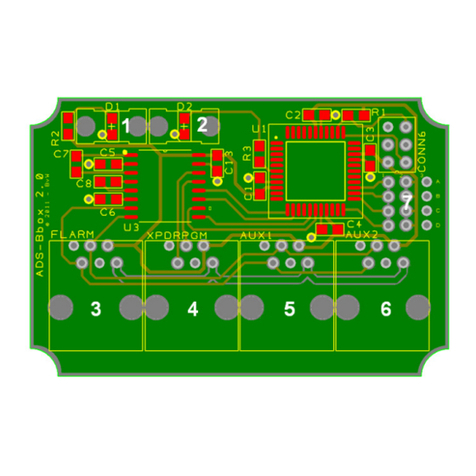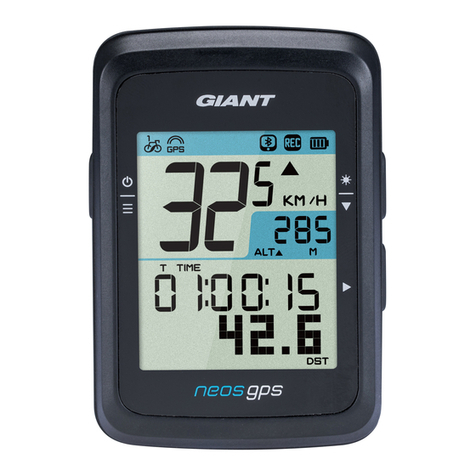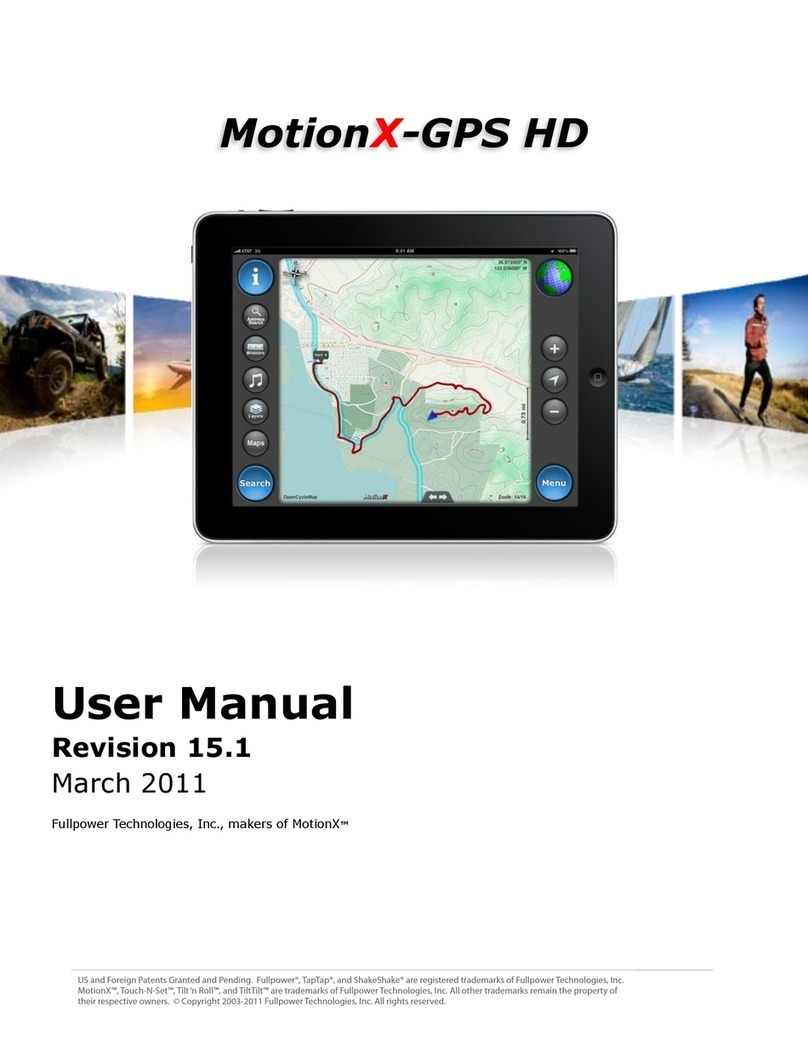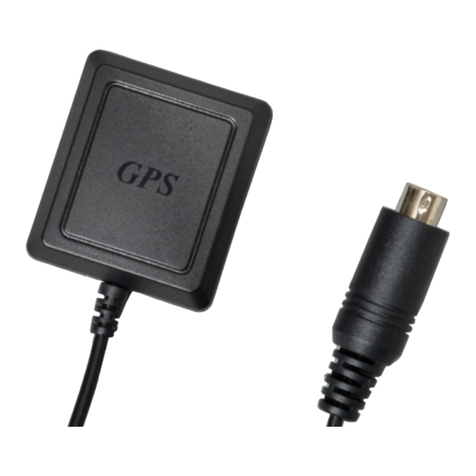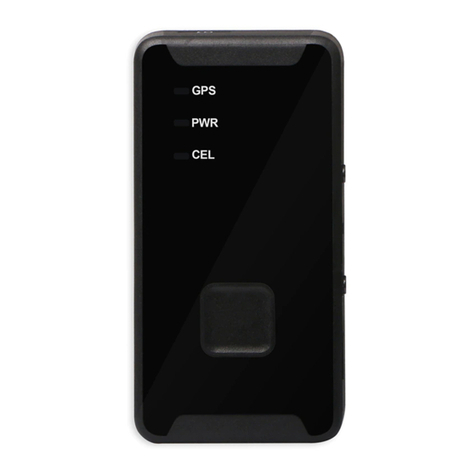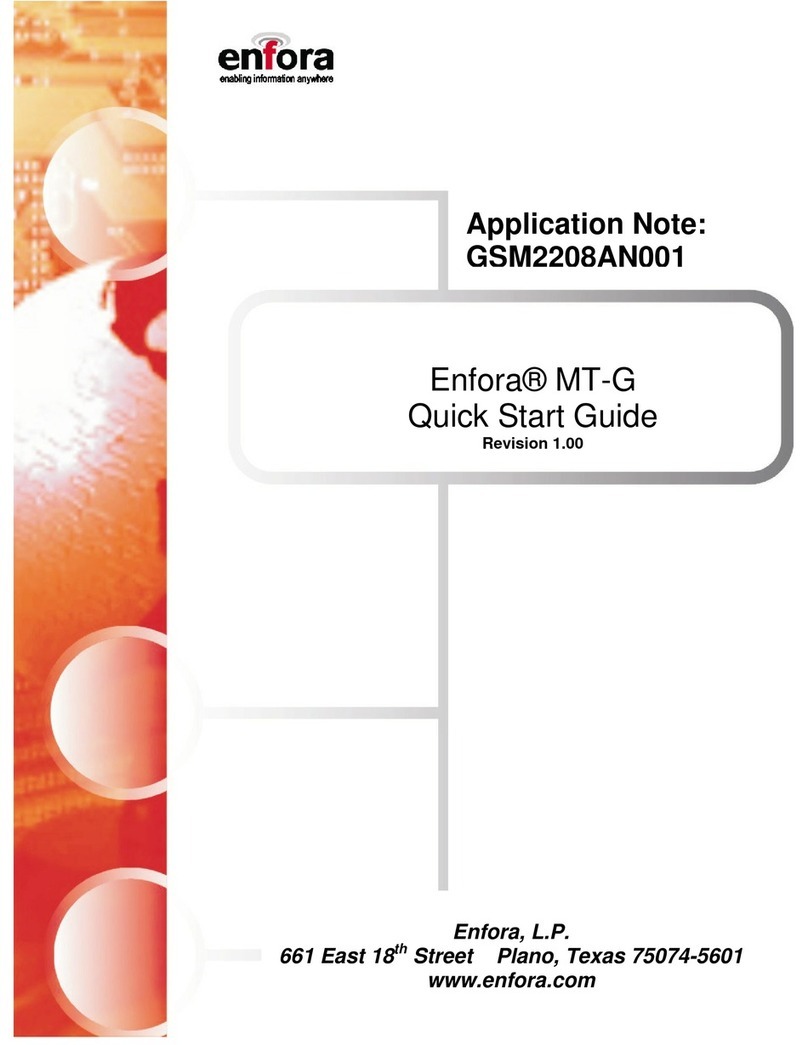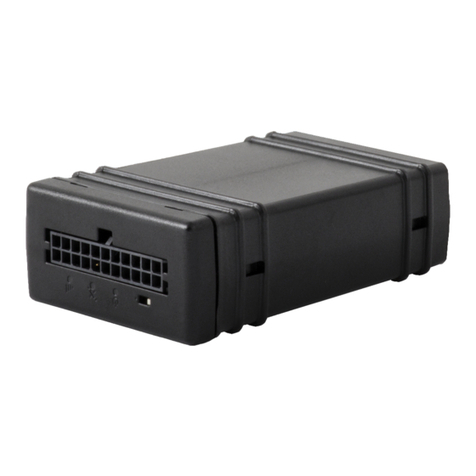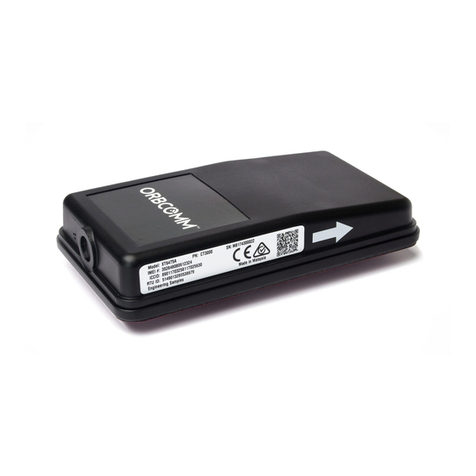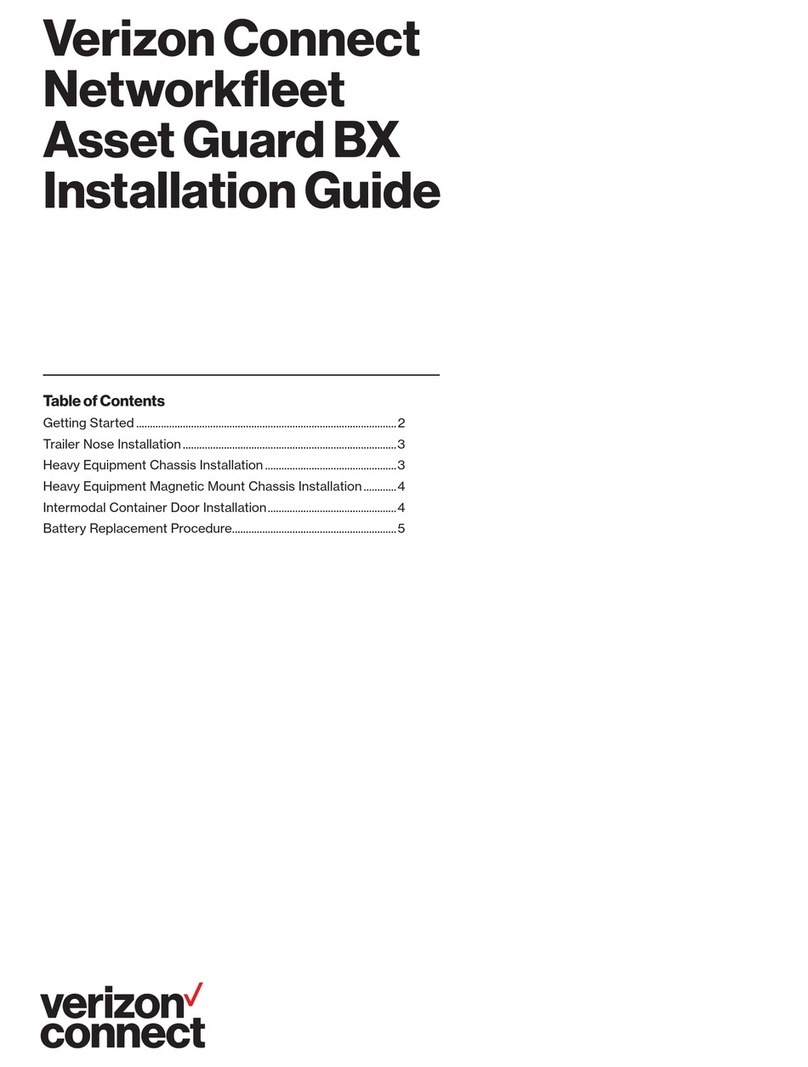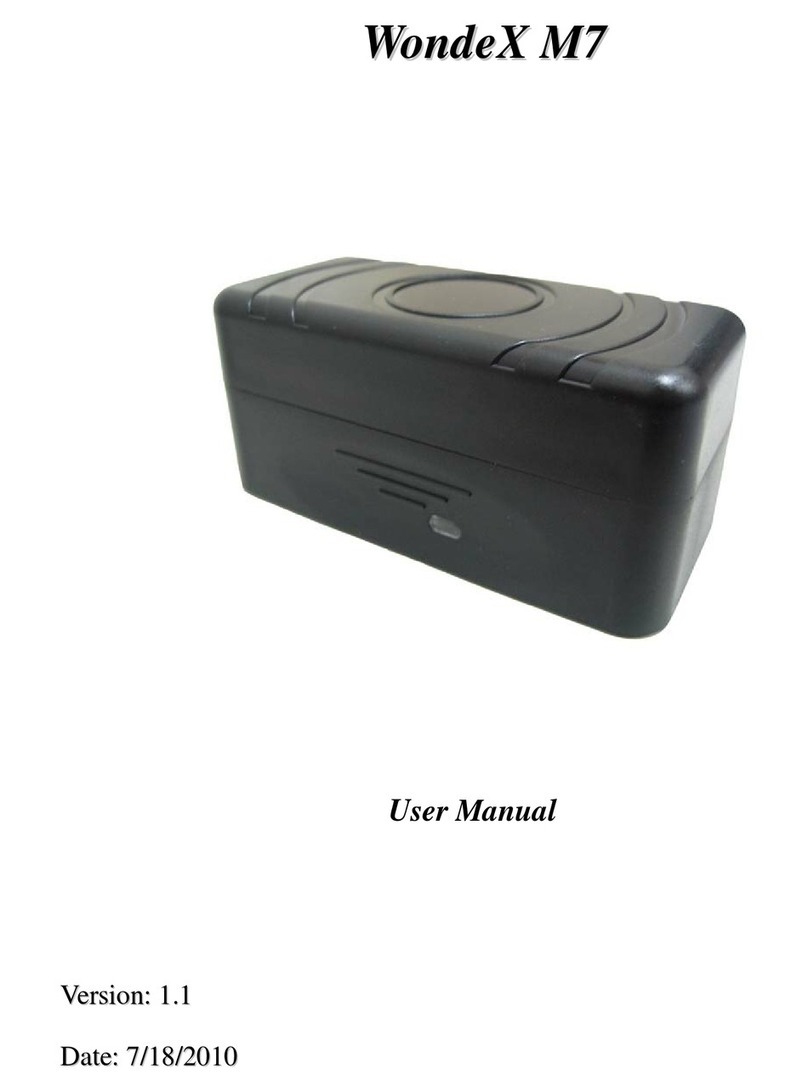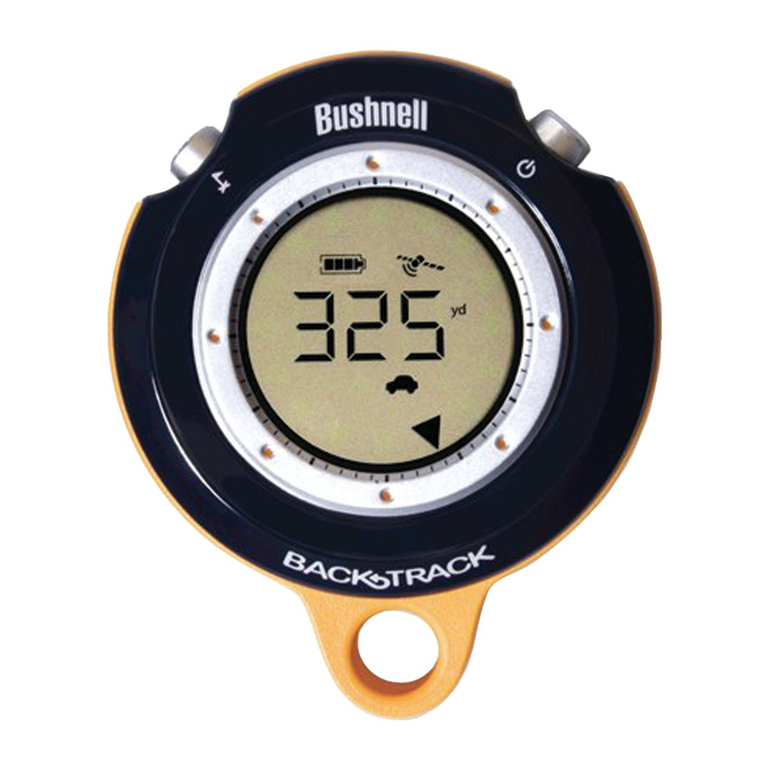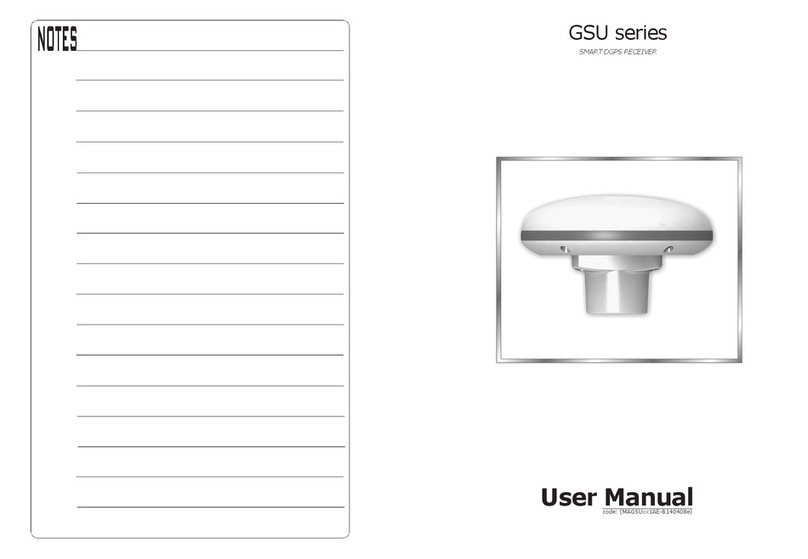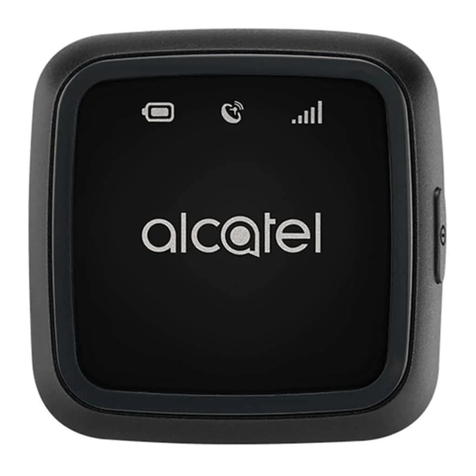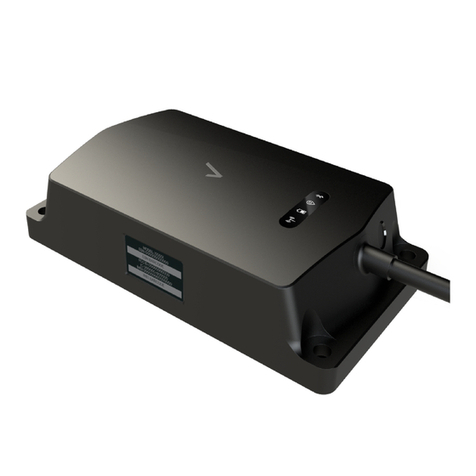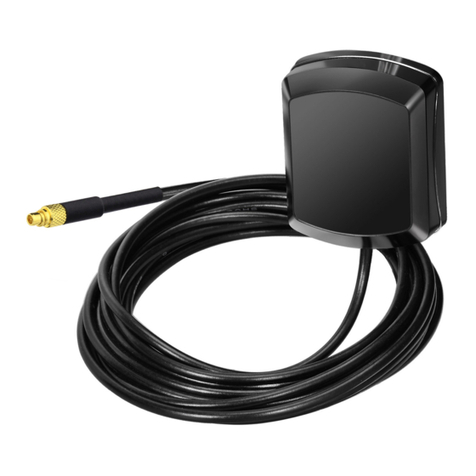FLARM PowerFLARM Portable User manual

PowerFLARM Manual Version 1.0
1
Manual
Version 1.0

2
Contents
Introduction ............................................................... 4
Installation ................................................................. 6
General Advice on Installation.........................................................6
Housing .....................................................................................................8
Connections.............................................................................................9
Overview .................................................................................................... 9
Power and Data Connections ........................................................... 9
Audio..........................................................................................................10
Communications Antennas..............................................................10
GPS-System...........................................................................................11
Operation with an internal Antenna ..........................................11
Operation with an external Antenna..........................................11
FLARM®-COMMUNICATIONS......................................................12
Transponder and ADS-B Reception............................................12
Audio .......................................................................................................13
Micro SD-Card......................................................................................13
Insertion and Removal ......................................................................13
Power Supply.......................................................................................14
Power Supply using the Aircraft's own Electrical Power
System .......................................................................................................14
Power Supply Using Batteries or Rechargeable Batteries14
Battery Insertion..................................................................................15
Rechargeable internal Batteries...................................................15
Technical Data..................................................................................... 16
Operation ................................................................. 17
General Advice on Operation ........................................................17
Use...............................................................................................................17
Compatibility .........................................................................................17
Radio Range and Reception............................................................17
Position Determination.....................................................................18
Flight Path Calculation .....................................................................18
Data Protection ....................................................................................19

PowerFLARM Manual Version 1.0
3
Limitations..............................................................................................19
Certification............................................................................................19
Start-Up.................................................................................................. 19
Fault Reporting and other Information .................................... 20
Operation...............................................................................................20
Normal Operation..............................................................................21
Collision Warnings.............................................................................22
Warning Presentation.......................................................................22
Information about Warnings.........................................................23
Settings Menu ......................................................................................25
Menu Diagram ......................................................................................25
Essential Settings Prior to First Flight.......................................26
Selection of Aircraft Type.................................................................26
ICAO Address..........................................................................................26
Transponder...........................................................................................26
Legal Notes............................................................... 27
Product Guarantee.............................................................................27
Limitations............................................................................................ 27
Legal Liability ......................................................................................28
Conformity Declaration...................................................................28

4
Introduction
A PowerFLARM unit draws its position and movement
information from an internal GPS-receiver. The position
measured is rendered more accurate by an integral pressure
sensor. The unit calculates the predicted flight path and
transmits this information as a short, low-power digital signal
burst at one-second intervals together with a unique
identification code. At the same time, the unit receives similar
signals from FLARM units installed in other aircraft and within
radio range, or from aircraft equipped with ADS-B, Mode-C and
Mode-S transponders. The PowerFLARM unit compares the
signals received with its own projected flight path. An optional
future additional feature will be for PowerFLARM to compare its
own projected flight path with the positions of known fixed
obstacles (e.g. cables, aerials, cable railways, avalanche
detonation sites) held in the unit's data base.
If PowerFLARM determines one or more threats of a dangerous
conflict with another aircraft or obstacle, it warns the user of the
most dangerous threat as per the internal calculation. Acoustic
warnings are issued via a warning bleeper and headset audio
output, also an optical warning via an LCD display. These signals
indicate the height of the threat, the direction from which it has
been detected, and the height difference. During turns, a different
calculation algorithm is applied from that used in approximately
straight flight. The GPS- and collision threat data received are
also fed to a serial data port output for use by other units such as
an external display and PDA. Suitable equipment is available
from a number of suppliers.

PowerFLARM Manual Version 1.0
5
Warnings are issued in accordance with the time remaining to a
possible collision, not the geometric distance between the
aircraft. The first warning is typically issued between 19 and 25
seconds prior to the calculated possible collision with aircraft or
obstacle; the second is issued 14 to 18 seconds beforehand, and
the third 6 to 8 seconds in advance. Warnings are sustained as
long as the threat remains as calculated. Depending upon the
prediction, the threat may be downgraded or deleted. Warnings
are selective, i.e. they are only issued if the calculation detects a
high probability of a collision in the immediate future.
Communications between PowerFLARM units employ a
proprietary copyright protected protocol in different frequency
bands allocated by region. Effective range depends very much
upon the position in which device is fitted.
The communications system between units is locked against
unauthorised access. The design is patent protected. There is no
public access to the protocol. Any unlicensed use, copying,
distribution, conversion, replication, de-compiling, reverse
engineering, or further transmission of knowledge so acquired
relating to the system components or software, in whole or in
part, is forbidden and will result in legal enforcement action.
FLARM is an internationally registered Trade Mark and may not
be used by third parties without a license. Technical data may be
changed at any time and without prior warning. Some named
functions are not provided in all versions of PowerFLARM, but
may be provided at extra cost or for a fee.

6
Installation
General Advice on Installation
Installation and operation is on a non-interference and non-
hazard basis, and may not be allowed to endanger the safe
operation of certificated equipment that is either necessary or
required by regulation for safe flight. Installation must comply
with official requirements.
PowerFLARM must be so secured that the pilot can see the
displays, hear the acoustic warnings, and operate the turning-
button. PowerFLARM must not obstruct the pilot in his operation
of the aircraft (including emergencies); in particular at all times
it must not obstruct his view of the sky, even in the event of
serious vibration or acceleration. PowerFLARM is not suitable
for use in conjunction with night vision equipment, for night
flying, or in pressurised cabins.
Ideally, PowerFLARM will be fitted to the instrument panel glare-
shield or cockpit sidewall. If the PowerFLARM internal display is
in use, the rear face of the unit with cable connectors must face
the direction of flight. If the unit is coupled to an external display
with controls, PowerFLARM can be installed in another position
or point in a different direction. Usually, this will require the use
of separate communications and GPS aerials.
The installation must ensure that the communications antenna A
and ADS-B are not in contact with any other objects through
which there might be a regular electrostatic discharge.
For example, the communications antenna should not be in
permanent contact with the cockpit windscreen inner face,
because this could result in damage to the PowerFLARM
communications transceiver. The unit will not operate properly
in the absence of an antenna or if the antenna is not properly
screwed tight; the unit cannot self-test for correct antenna
function.

PowerFLARM Manual Version 1.0
7
For updates, configuration and flight data evaluation it is helpful
if the unit is installed such that the power and data connectors
and the microSD-reader are easily accessible or reachable with
an extension cable. The PowerFLARM serial number must be
known for software updates.
It is advisable that the PowerFLARM is so fitted to the aircraft
that the turn-button cannot be inadvertently pressed during
entry to or egress from the aircraft. Should the PowerFLARM or
any associated components be fitted to a part of the aircraft that
will be jettisoned in an emergency, suitable break points should
be incorporated to prevent any interference with the jettison
sequence.
Cables must not be folded or placed under tension. Adequate
space must be left for the cable connectors. Cables for power
supply, data, and external units must be shortened as necessary:
to prevent the occurrence of inductive effects they may not be
coiled. Only a single PowerFLARM may be installed in each
aircraft.
The PowerFLARM and any associated aerials should be located
as far away as possible -- at least 25 cm -- away from any other
GPS aerial and the magnetic compass.
After installation, an inspection must be made to ensure that the
PowerFLARM unit does not interfere with any mechanical,
electrical, electronic (radio) or magnetic (e.g. compass) system,
and this fact must be recorded in the aircraft documents. In
addition, the aircraft documents must bear a record of the
PowerFLARM serial number and Software Version Number. If
employed in a fixed installation, the Means of Compliance must
be recorded in the aircraft documentation, and an AFM
Supplement is to be carried on board the aircraft.

8
Housing
The lower face of the polycarbonate housing has two threaded
screw holes, so that PowerFLARM may be easily secured using
two M4 screws (max. 10 mm long). The thread matches those of
most standard fixtures. The PowerFLARM must be fitted to a flat
surface and the housing not subjected to any mechanical stress.
Several types of fixture are available.
The housing can also be secured using DualLock® industrial
hook and loop tape, which can be secured and released several
times. Users should note that the adhesive used on DualLock® is
exceptionally strong and will not easily release. The adhesive
tape should not cover the battery compartment lid, but should be
applied elsewhere on the housing.
The housing is not air or watertight and users should avoid the
ingress of solid particles and liquids. Should the unit get moist, it
must be completely dried prior to further use. If the unit
becomes wet, it may be permanently damaged and rendered
unusable; no guarantee claim will be accepted for any unit
damaged by moisture. Should the unit be suddenly cooled this
may result in the formation of condensation. The housing may
only be cleaned using a slightly moist non-abrasive cloth without
a chemical cleaning agent. The housing does not resist scratches
or abrasion.
The plastic housing is black to reduce glare and has been tested
in the temperature range -10 °C to +60°C. Care should be taken
to avoid over-heating due to direct or indirect sunshine, in
particular because the housing can become deformed at
temperatures above +84 °C without any mechanical tension, and
also at lower temperatures. The unit must not be locally over-
heated by exposure to focused sunrays, and care is required
when cockpit doors or canopies have been opened (risk of fire to
due lens effect).

PowerFLARM Manual Version 1.0
9
Connections
Overview
Power and Data Connections
The 8-pin RJ45-socket accepts and retains an 8-pin (temporarily
also a 6-pin) plug. The pin connection is mostly in accordance
with IGC GNSS FR specifications.
(http://www.fai.org/gliding/system/files/tech_spec_gnss.pdf).
An 8-pin (temporarily also a 6-pin) ribbon cable with an RJ45
push-fit connector or an 8-pin twisted-pair patch cable with RJ45
may be used. Suitable cables are obtainable from retailers.
1: +8 to +27V DC
2: +8 to +27V DC
3: PowerFLARM supplies + 3V DC
4: GND
5: TX (RS232): only 1 user!
6: RX (RS232): only 1 user!
7: GND
8: GND
Pin 1 Pin 8 (view from rear)
For 8-pin cables Pins 1=2 are to be linked. Also Pins 7=8. If the
other wires are not to be used, they should be individually
insulated and may not be soldered together or twisted in pairs.

10
If the incoming power supply uses the Power/Data
connection, special attention must be given to the
instructions given in the chapter in this handbook
entitled Electrical Power Supply.
The transparent plug must be examined to determine the cable
colour coding so the open cable end may be correctly configured.
On patch cables the neighbouring wires of Pins 1/2, 3/4, 5/6 and
7/8 are usually twisted together. Neighbouring wires are usually
of the same colour, though one of the two colours alternates with
white.
As standard, Pin 5 transmits the most important NMEA-0183
Version 2.0 compatible GPGGA and GPRMC information at a
configured data rate, and Garmin proprietary PGRMZ barometric
height information. Further information is available for third-
user devices (e.g. external display). Do not connect more than
one external application at the same time.
Audio
The audio signal is a standard de-coupled aviation signal of no
more than 1 V. The connector is a standard 3.5 mm jack plug.
Communications Antennas
The primary communications antenna for the FLARM protocol is
preinstalled and locked to the FLARM A socket. Do not try to
remove this antenna as this may cause damage to the device. For
proper operation the included ADS-B antenna must be carefully
and tightly screwed to the SMA socket marked with ADS-B. The
installation has a great influence upon both transmission and the
reception range achieved, and thus requires careful
consideration. The antennas must be vertical to ensure
unimpeded emission especially to the front, and to the sides.
Users are advised not to install the unit within or under the
instrument panel without external antennas. In principle, the
installation may be inverted, provided that the unit is connected
only to an external display and an external GPS antenna.
Horizontal or non-upright antenna presentation is unacceptable.
No electrically conducting surfaces (e.g. metal, carbon fibre)

PowerFLARM Manual Version 1.0
11
should be located over or immediately alongside the antennas.
The antennas must not be subjected to physical pressure (e.g.
cockpit windscreen) and may not be bent.
If a second FLARM communications antenna (used
for reception of FLARM signals only, not included)
should be connected to socket B, it must be located
at least 1.5 metres from the unit.
Alternative offset antennas, external antennas and antenna
extension cables (50Ω on normal SMA) can be obtained from
retailers. An externally mounted antenna must be properly
earthed with the aircraft. The installation must be within a Zone
2A or 3 as defined by DO-160/F Section 23.
GPS-System
The GPS system in PowerFLARM is subject to the limitations
found in typical GPS applications. The system is not certified for
aviation use.
PowerFLARM will not work without adequate
reception.
PowerFLARM can be operated using both the GPS antenna
within the housing and with an external GPS antenna (not
supplied) connected to the MCX socket. Connecting an external
antenna automatically deactivates the internal antenna.
Operation with an internal Antenna
When operating with the internal GPS antenna, the unit
presentation must be unhindered to the sky ahead and sides.
Further, the upper side of the unit must not be covered.
Operation with an external Antenna
The antenna should be located in an upright position such that it
has an unhindered presentation to the sky, including when the
aircraft is in a turn. There should be no electrically conducting
surfaces (e.g. metal, carbon fibre) over or immediately alongside
the antenna. Ideally, the antenna will sit atop the instrument
panel coaming. Conducting surfaces under the antenna may have

12
a positive effect upon antenna function. Users are advised not to
install the PowerFLARM unit within or under the instrument
panel cover.
If more than one GPS antenna is present, it is recommended that
they are at least 25 cm apart; the same holds good for separation
from the PowerFLARM communications antenna.
FLARM®-COMMUNICATIONS
The PowerFLARM radio communications are made using a
public frequency band known and requiring no user licence.
This means that the band is also used by a number of other
applications. FLARM has no exclusive rights to use the frequency
band, so there is no guarantee that FLARM reception will be free
from interference by other users.
The use of unlicensed bands by aircraft is subject to a number of
limitations, with some national differences. The pilot and user of
PowerFLARM are solely responsible for ensuring that the unit is
used in accordance with the current local regulations.
Essentially, the PowerFLARM communications protocol places
no limit on the number of units that may be contacted within the
working range. However, an increasing number of PowerFLARM
units within range leads to a reduction in the probability
('graceful degradation'), that a single signal report can be
received. But the probability that the next signal from the same
transmitter will not be received is generally small. PowerFLARM
is designed to simultaneously receive and process the signals
from more than 50 aircraft within radio range. A large number of
signals from other aircraft does not reduce the working range.
Transponder and ADS-B Reception
The ADS-B and transponder antennas are inserted and screwed
to the reverse-polarity SMA socket as marked. Make sure you do
not mistakenly insert the FLARM communications antenna in the
SMA socket, and do not use any force.

PowerFLARM Manual Version 1.0
13
Audio
To make sure that an acoustic warning can be heard above loud
ambient noise, the signal may be fed direct into the intercom or
headset. To this end, there is a 3.5 mm socket for a jack plug on
the rear side of the unit.
PowerFLARM also has an integral warning bleeper. The housing
front face has an outlet to improve sound release from the
internal bleeper. This outlet must not be obstructed by any
adhesive agent.
When set at large volume, the bleeper sound level
could damage a human ear at close distance. The
volume is adjustable.
Micro SD-Card
FLARM has a built-in microSD card reader. The microSD card
(also known as TransFlash) is not supplied, but is in widespread
use for mobile telephones and can be purchased from most
camera or mobile phone retailers. FLARM uses the microSD card
to update the firmware, obstacle and terrain data, to configure
the unit and download the flight log.
Some functions are not available in all
PowerFLARM versions; these may be available for
payment of an additional charge or fee.
microSD cards are smaller than SD cards or miniSD cards.
However, for communication with a PC there are mechanical
adapters for insertion of a microSD card in SD or a miniSD card.
Such adapters are often sold together with the cards.
Note, that the microSD card must be formatted to FAT or FAT32.
Insertion and Removal
Hold the card with the metal contacts on the right and insert
carefully into the slot; then, gently press with the fingertip until
the card is retained with a slight 'click'. To remove the card,
press the card gently into the FLARM slot until a slight click

14
releases the card, which can then be gently withdrawn. Do not
use force.
Power Supply
PowerFLARM can be operated using the aircraft's own electrical
power system, internal or external rechargeable batteries.
Power Supply using the Aircraft's own Electrical Power
System
If the unit draws its electrical power through the Power/Data
socket, there must be a direct galvanic link between the FLARM
and aircraft battery via a 500 mA circuit breaker. This power
supply must be separate from any other instruments that are
essential for the safe conduct of the flight. In flight the pilot must
be able to isolate the FLARM unit from the aircraft's electrical
power system without interrupting the power supply to any
other important systems. Possible reasons might be a suspected
fault in other on-board systems, the presence of smoke, the smell
of smoke, or flying over a country where the operation of FLARM
is forbidden.
In spite of the integral electrical polarity guard, it is important
not to confuse the power supply with the data cable.
Power Supply Using Batteries or Rechargeable
Batteries
PowerFLARM can be operated using different types of batteries
or rechargeable batteries. The unit requires six AA cells or
compatible products:
-Alkaline Batteries (Alkaline Manganese Cells)
-Nickel Metal hydride (NiMh) rechargeable batteries
The unit should not be operated in conjunction
with any other types of battery; other types may
damage PowerFLARM.

PowerFLARM Manual Version 1.0
15
PowerFLARM recognises the type of non-chargeable or
chargeable batteries that have been fitted and responds
accordingly.
Battery endurance depends upon the type of
battery, the incidence of traffic, and display
brightness.
The battery life remaining is indicated above the
battery symbol on the right upper corner of the traffic
display.
Battery Insertion
PowerFLARM has a battery compartment on the lower face, and
holds six AA batteries. The batteries are inserted by removing
the compartment lid. It is essential to ensure that the batteries
are inserted with the correct polarity, with no excessive
application of force on the battery compartment lid.
Rechargeable internal Batteries
PowerFLARM features an internal NiMH battery charger. When
the device is turned off and electrically connected to the vehicle
or aircraft battery (either via “Power” socket or power pins on
the RJ45 socket), inserted batteries will be charged if the
ambient temperature lies within the allowed range for charging
NiMH batteries.
If non-rechargeable batteries are fitted to the unit,
do not connect your PowerFLARM device to an
external power source (e.g. aircraft or vehicle
battery).
The internal batteries may only be charged if the unit is resting
on an inflammable, dry base. When the unit is being recharged,
never allow it to remain unsupervised.

16
Technical Data
Dimensions:
x
Length: 94mm
x
Width: 96mm
xHeight: 46mm
Operation:
x
Integral turn/push button
Audio:
xBuilt-in warning b
eeper
x
Output for Headset Audio
xVolume control
Communication:
xInternal RS232 NMEA
xData output for Moving-
Map
unit and external displays
(only one user at
a time!)
x
internal power supply for
external units
Sensors and GPS:
xPressure sensor
xMicrophone
xIntegral 50-
channel GPS
receiver
FLARM:
x868MHz FLARM
Transceiver
ADS
-B:
x1090 MHz receiver for
Mode-C/S and ADS-B
signals
Antennas:
x868MHz FLARM antenna
(preinstalled and locked)
xADS-
B antenna (on housing,
rpSMA-socket)
x
Integral GPS antenna
xExternal GPS-antenna,
optional connection (MCX-
socket)
Memory:
xSD card slot (Micro-SD)
x
Update via SD card possible
Fixtures:
x
Two threaded holes for M4
screws
xAdapter plates
and holders
(optional)
Display:
xNew generation sunlight-
readable Matrix TFT display
x
Resolution 132 x 176 pixels
x2 inch diagonal screen
Operation:
x
Integral push/turn button
xZoom and settings
Power Supply and Batteries:
x
6 removable AA batteries (non-
re
chargeable or rechargeable)
x
Integral, intelligent battery
charger with temperature
monitor
x
Can operate directly attached
to aircraft on
-board electrical
power: 10 to 26V DC
x
Up to 5h battery life,
(depending upon traffic and
type of battery)

PowerFLARM Manual Version 1.0
17
Operation
General Advice on Operation
Use
PowerFLARM is designed for use in non-essential conditions
as a 'situation awareness only' device, only to support and
assist the pilot. It cannot always be relied upon to provide a
warning of collision threat. When using FLARM, under no
circumstances should the aircrew adopt any change in flight
tactics, or modify the actions of the user or aircraft
commander. Even though you have installed a FLARM unit,
you remain personally responsible for the safe conduct of
the flight, the safety of your passengers and other aircraft in
the vicinity. Users of FLARM do so entirely upon their own
responsibility and that of the aircraft commander. The
FLARM unit may only be operated by persons who are
thoroughly familiar with the user instructions.
Compatibility
FLARM warnings of the presence of other moving aircraft can
only be given if the latter is also equipped either with FLARM or
other compatible unit, or a compatible SSR-reply system
(Transponder Mode-C/S). FLARM does not communicate actively
with Mode A/C/S transponders, and is thus not detected by
ACAS/TCAS/PCAS or terrestrial air traffic control.
Radio Range and Reception
If a warning is to be issued, compatible equipment must be
located within range. This range is greatly dependent upon the
type and position of the communications antenna installation on
the aircraft, also the spatial relationship of the two aircraft to
each other.

18
FLARM signals between two aircraft are only possible in a line of
sight; there can be no signal between two aircraft on opposite
sides of the same mountain.
Position Determination
To operate correctly FLARM must be constantly aware of its own
current position, for which reason it will only operate if there is
good, three-dimensional GPS reception. GPS reception is greatly
influenced by the correct installation and position of the GPS
antenna and aircraft attitude. It also requires that the US GPS
system is in full and unrestricted use. Especially when flying in a
turn, close to hills or mountainsides, in areas where reception is
known to be unreliable, or if the antenna installation is poor, the
GPS signal quality may be degraded; this also causes rapid
deterioration of height calculation. FLARM operates correctly
again when the GPS signal quality is restored.
The movements registered by a GPS relate to a fixed system of
terrestrial coordinates. When the wind is strong, the aircraft
heading deviates from Track over Ground, and this has an effect
upon the collision threat calculated. If the wind speed is one
third of True Airspeed (TAS) and the aircraft heading is at 90° to
the wind and with no drift, then the display has an error of e.g.
18°. If the wind is very strong the Track over Ground can deviate
as much as 180° from the Heading. If the aircraft is circling, the
calculation and thus collision warning threat are unusable.
In the event of poor GPS reception, for aircraft at close distance
and at similar heights, the angle offset from the vertical is
imprecise and irregular.
Flight Path Calculation
FLARM calculates its own predicted flight path for about the next
20 seconds. The prognosis is based upon immediate past and
current vectors, plus a movement model that has been optimised
for the respective user. This prognosis incorporates a number of
errors that increase with the duration predicted. There is no
guarantee that the aircraft will fly along the projected flight path.
For this reason, a prediction may not be accurate in every case.

PowerFLARM Manual Version 1.0
19
In light aircraft, flight path predictions of more than half a minute
are unusable.
Data Protection
The transmitter has no influence on what a receiver does with
the data received. It is possible that this data might be logged by
other airborne or ground stations and then used for other
purposes. In many instances this could be to the user's advantage
(e.g. automated flight log, flight tracking, last position recovery):
The data could also be used as evidence against the aircraft’s
airspace or height violations or collision avoidance actions. With
each signal FLARM transmits a unique identification code
relating to the aircraft or pilot.
Limitations
The use of FLARM is strictly limited to non-commercial flights in
daylight under VFR (Visual Flight Rules). FLARM may not be
used for navigation or in aerobatics.
Certification
FLARM has not undergone the conventional aeronautical
certification process. FLARM software development was
conducted in accordance with the usual standards and
procedures required for industrial electronics products.
Start-Up
To switch on PowerFLARM, the operating button must be
pressed for at least three seconds.
A start-up display then appears with
further information about the battery
charge condition.
After start-up, the PowerFLARM display shows how many GPS
satellites have been found. As soon as GPS reception is sufficient
to give a worthwhile determination of position, PowerFLARM
then switches to normal operation.

20
Fault Reporting and other Information
During normal operation the PowerFLARM display advises the
user on operational conditions. In addition, PowerFLARM has a
self-test function. Should it detect a fault, the unit will display a
fault report. Several types of reports might be displayed:
Serious Fault: Operation may not continue.
Caution / Fault: A fault has occurred and/or
extra care is required.
Information: Simple information report, no
fault.
Operation
PowerFLARM is operated using the integral turn-button with
push function.
Turn/push-button
The following table gives a brief overview of the most important
push-button combinations.
Brief push on button
Select / Enter
Longer push on button
Open/Close menu
Very long push on button
Switch On/Off
Turn button
Choose zoom depth, or select
Other manuals for PowerFLARM Portable
3
Table of contents
Other FLARM GPS manuals
